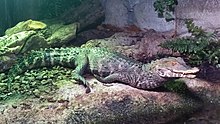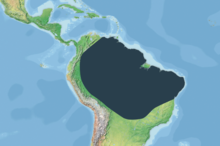Cuvier's dwarf caiman
| Cuvier's dwarf caiman | |
|---|---|

| |
| Scientific classification | |
| Domain: | Eukaryota |
| Kingdom: | Animalia |
| Phylum: | Chordata |
| Class: | Reptilia |
| Clade: | Archosauromorpha |
| Clade: | Archosauriformes |
| Order: | Crocodilia |
| Family: | Alligatoridae |
| Subfamily: | Caimaninae |
| Genus: | Paleosuchus |
| Species: | P. palpebrosus
|
| Binomial name | |
| Paleosuchus palpebrosus Cuvier, 1807
| |

| |
| Range in black | |
| Synonyms[4] | |
|
List
| |
Cuvier's dwarf caiman (Paleosuchus palpebrosus) is a small crocodilian in the alligator family from northern and central South America. It is found in Bolivia, Brazil, Colombia, Ecuador, French Guiana, Guyana, Paraguay, Peru, Suriname, Trinidad and Venezuela. It lives in riverine forests, flooded forests near lakes, and near fast-flowing rivers and streams. It can traverse dry land to reach temporary pools and tolerates colder water than other species of caimans. Other common names for this species include the musky caiman, the dwarf caiman, Cuvier's caiman, and the smooth-fronted caiman (the latter name is also used for P. trigonatus). It is sometimes kept in captivity as a pet and may be referred to as the wedge-head caiman by the pet trade community.
Cuvier's dwarf caiman was first described by the French zoologist
Etymology and taxonomy
| |||||||||||||||||||||||||||||||||||||||||||||||||||||||||||||||||||||||||||
| Phylogenetic relations of Paleosuchus palpebrosus within Caimaninae[5] |
Cuvier's dwarf caiman was first described by Cuvier in 1807 as Crocodylus palpebrosus from a type locality described as "Cayenne". Since then, it has been given a number of names by different authorities: Crocodilus (Alligator) palpebrosus (Merrem, 1820), Jacaretinga moschifer (Spix, 1825), Champsa palpebrosa (Wagler, 1830), Alligator palpebrosus (Dumeril and Bibron, 1836), Champsa gibbiceps (Natterer, 1841), Caiman palpebrosus (Gray, 1844), Caiman (Aromosuchus) palpebrosus (Gray, 1862), and Jacaretinga palpebrosus (Vaillant, 1898). Muller, in 1924, and Schmidt, in 1928, were the first to use the currently accepted name of Paleosuchus palpebrosus. No subspecies are recognised.[6]
A genetic study in 2012 found clear differences between various populations of Cuvier's dwarf caiman (Pantanal; Madeira River basin; Rio Negro basin), and these are apparently isolated from each other,[7] leading to the suggestion that it may be a cryptic species complex.[8]
At present, the
Common names include the musky caiman, the dwarf caiman, Cuvier's caiman, and the smooth-fronted caiman,[9] although the last of these is also used to refer to the closely related P. trigonatus. In the pet trade, it is sometimes referred to as the wedge-head caiman.[10]
Description
Cuvier's dwarf caiman is the smallest living New World crocodilian. Males grow to a maximum length around 1.6 m (5.2 ft) while females do not usually exceed 1.2 m (3 ft 11 in).[6] The largest specimen on record measured 1.73 m (5.7 ft) in length.[11] This may be an underestimate of the animal's maximum size, as nearly all large adults have lost the tips of their tails and the largest specimen measured in the Pantanal region had a snout–vent length of 1.125 m (4 ft) (equivalent to a total length of 2.1 m (6.9 ft) with an intact tail).[12] An adult typically weighs around 6 or 7 kg (13 or 15 lb), around the same weight as a 6- to 12-month-old specimen of several larger species of crocodilians.[13] Large adults of this species can weigh up to 37 kg (82 lb).[14] Cuvier's dwarf caiman has strong body armor on both its dorsal (upper) and ventral (lower) sides, which may compensate for its small body size in reducing predation. The dermal scales providing this protection have a bony base and are known as osteoderms.[6][15]
The head has an unusual shape for a crocodilian, with a dome-shaped skull and a short, smooth, concave snout with an upturned tip, the shape rather resembling the head of a dog. The upper jaw extends markedly further forward than the lower jaw. Four premaxillary and 14 to 15 maxillary teeth are on either side of the upper jaw and 21 or 22 teeth on each side of the lower jaw, giving a total of about 80 teeth. The neck is relatively slender and the dorsal scutes are less prominent than in the smooth-fronted caiman. The double rows of scutes on the tail are small and project vertically. Adults are dark brownish-black with a dark brown head, while juveniles are brown with black bands. The irises of the eyes are chestnut brown at all ages and the pupils are vertical slits.[6][15]

The scutellation (arrangement of the scales) helps to distinguish Cuvier's dwarf caiman from Schneider's dwarf caiman.[6]
| Scutellation trait | Cuvier's dwarf caiman | Schneider's dwarf caiman |
|---|---|---|
| Post occipitals | Usually 2 rows | Usually 1 row |
| Nuchals | Usually 4–5 rows | Usually 4 rows, sometimes 5 |
| Dorsals | 18 longitudinal rows and 6–10 transverse rows, neatly arranged, with 4 rows between hind legs | 18 longitudinal and 6–7 transverse rows, haphazardly arranged, with usually 2 rows between hind legs |
| Ventrals | 21–22 longitudinal rows and 16 transverse | 19–21 longitudinal and 10–12 transverse rows |
| Tail – single crest | Usually 19–21 scales | Usually 17–19 scales |
| Tail – double crest | Usually 9 or 10 rows | Usually 9 or 10 rows |
| Tail – lateral | Small scales disrupt 2–3 rows | 5–8 rows |
Distribution and habitat
Cuvier's dwarf caiman is native to tropical northern and central South America. It is present in the drainages of the
Cuvier's dwarf caiman is a freshwater species and is found in forested riverine habitats and areas of flooded forest around lakes. It seems to prefer rivers and streams with fast-flowing water, but it is also found in quiet, nutrient-poor waters in Venezuela and southeastern Brazil. It is able to travel quite large distances overland at night and subadult individuals have sometimes been found in isolated, temporary pools. In the northern and southern parts of its range, it is also found in gallery forests in savanna country, but it is absent from such habitats in the Llanos and the Pantanal. Cuvier's dwarf caiman seems relatively tolerant of cool water compared to other species of caimans. During the day, individuals sometimes lie up in burrows[6][15] but at other times rest on piles of rocks or sun themselves while lying, facing the sun, in shallow water with their backs exposed.[16]
Behaviour and ecology
These caimans are mainly nocturnal. Because they occupy many different microhabitats, their diet is believed to vary regionally. in burrows during the dry season and is able to maintain its temperature around 22 °C (72 °F) for days at a time.

Adult Cuvier's dwarf caimans are usually found singly or in pairs. The breeding of this species has been little studied, but it does not appear to be seasonal in nature. The female builds a mound nest out of vegetation and mud somewhere in a concealed location and lays a clutch of 10 to 25
Cuvier's dwarf caiman is considered to be a
The Cuvier's dwarf caiman is the only crocodilian species that seemingly does not perform the near-universal "death roll" technique used by other extant crocodilians for feeding or intra-specific combat. However, this may only be circumstantial, as specimens tested for the behavior may have been acting uncooperatively with the researchers.[20]
Status and conservation
Many crocodilians are hunted for their skins, but this is not the case with the Cuvier's dwarf caiman. This may be because the ventral skin in this species is too heavily armored to make it easy to tan. Some individuals are killed by indigenous peoples for food and some traditional South American cultures believe dwarf caiman teeth protect from snake bites.[11] Others, particularly in Guyana, are collected for the pet trade; but no evidence shows that populations are dwindling as a result.[6] Some threats to this species are from habitat destruction, including the mining of gold, but these are not thought to be of great significance. The estimated total population is over a million individuals.[6]
In its Red List of Threatened Species, the IUCN lists Cuvier's dwarf caiman as being of least concern, which is because its range is extensive, covering much of northern and central South America, and although its population trend is unknown, it appears to be abundant in many of the localities in which it is found.[2] It is listed in Appendix II of CITES.[3]
Captive care
Cuvier's dwarf caiman can be kept as a pet, though providing suitable care is expensive and requires extremely large enclosures. In many countries, permits or licenses are necessary and most veterinarians have little experience with these exotic animals.[21]
See also
References
- PMID 34567843.
- ^ . Retrieved 19 November 2021.
- ^ a b "Appendices | CITES". cites.org. Retrieved 2022-01-14.
- ^ Uetz, Peter; Hallermann, Jakob. "Paleosuchus palpebrosus (Cuvier, 1807)". Reptile Database. Retrieved 2014-06-17.
- S2CID 32793915.
- ^ a b c d e f g h i j k l m Britton, Adam (2009-01-01). "Paleosuchus palpebrosus (Cuvier, 1807)". Crocodilian species list. Retrieved 2013-10-28.
- ^ a b Muniz, F.L. (2012), Filogeografia e genética de populações de jacaré-paguá (Paleosuchus palpebrosus) ao longo do rio Madeira e bacia do rio Paraguai (Pantanal), National Institute of Amazonian Research / Federal University of Amazonas
- ^ a b Muniz; Bittencourt; Farias & Campos (2015). "New records on the occurrence of Paleosuchus in the Branco River Basin, Roraima state, Brazil". Crocodile Specialist Group Newsletter. 34 (4): 8–11.
- ^ "Cuviers dwarf caiman care sheet". Reptile forums UK. 2009-09-28. Retrieved 2014-06-11.
- ^ "Baby wedgehead caiman". Underground Reptiles. Archived from the original on 2014-07-12. Retrieved 2014-06-11.
- ^ a b Britton, Adam. "Paleosuchus". Crocodilians: Natural History & Conservation. Crocodilian.com. Retrieved 2014-06-11.
- .
- ^ Cuvier's Dwarf Caiman, The Animal Files
- ISSN 1568-5381.
- ^ ISBN 9781853910920.
- ^ a b c d e Choi, H. (2004). "Paleosuchus palpebrosus: Dwarf caiman, Cuvier's smooth-fronted caiman". Animal Diversity Web. Retrieved 2014-06-11.
- ^ Dutra-Araújo, Diogo; Marioni, Boris; de Fraga, Rafael; da Silveira, Ronis (2017). "Snakes as prey of Cuvier's Dwarf Caiman (Paleosuchus palpebrosus: Alligatoridae), with a new observation from central Amazonia, Brazil". Herpetology Notes. 10: 169–170.
- ISSN 1678-4375.
- ISSN 0022-2933.
- ^ Infamous 'death roll' almost universal among crocodile species 2019-04-18 ScienceDaily
- ^ Britton, Adam. "Captive care". Crocodilian.com. Retrieved 2014-06-11.
External links
![]() Media related to Paleosuchus palpebrosus at Wikimedia Commons
Media related to Paleosuchus palpebrosus at Wikimedia Commons

